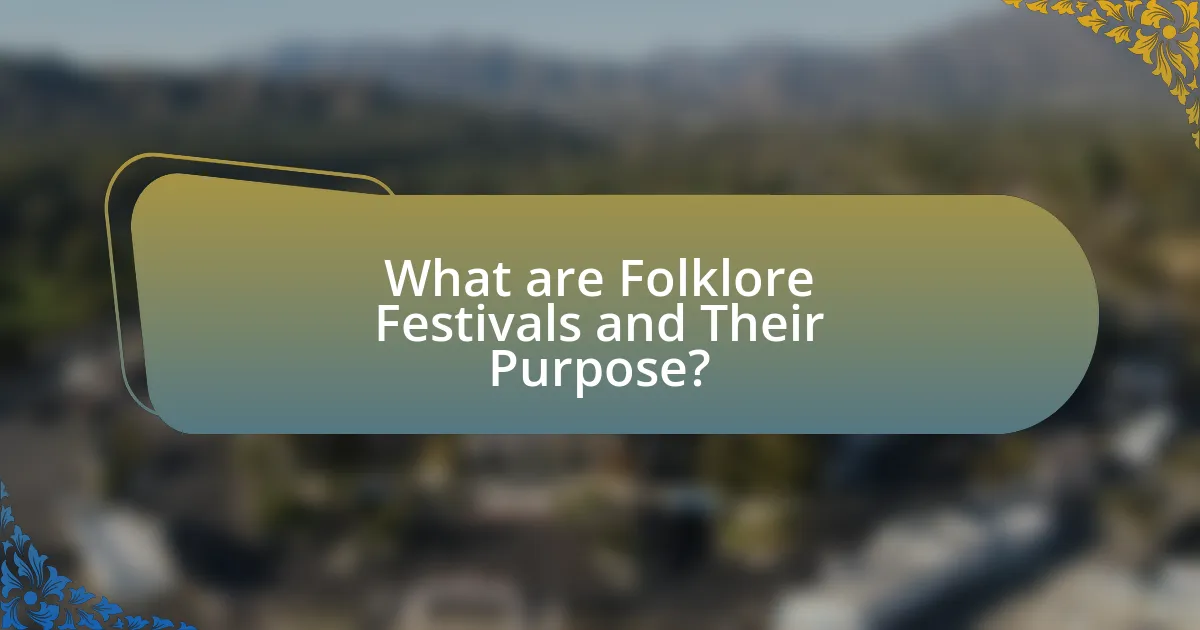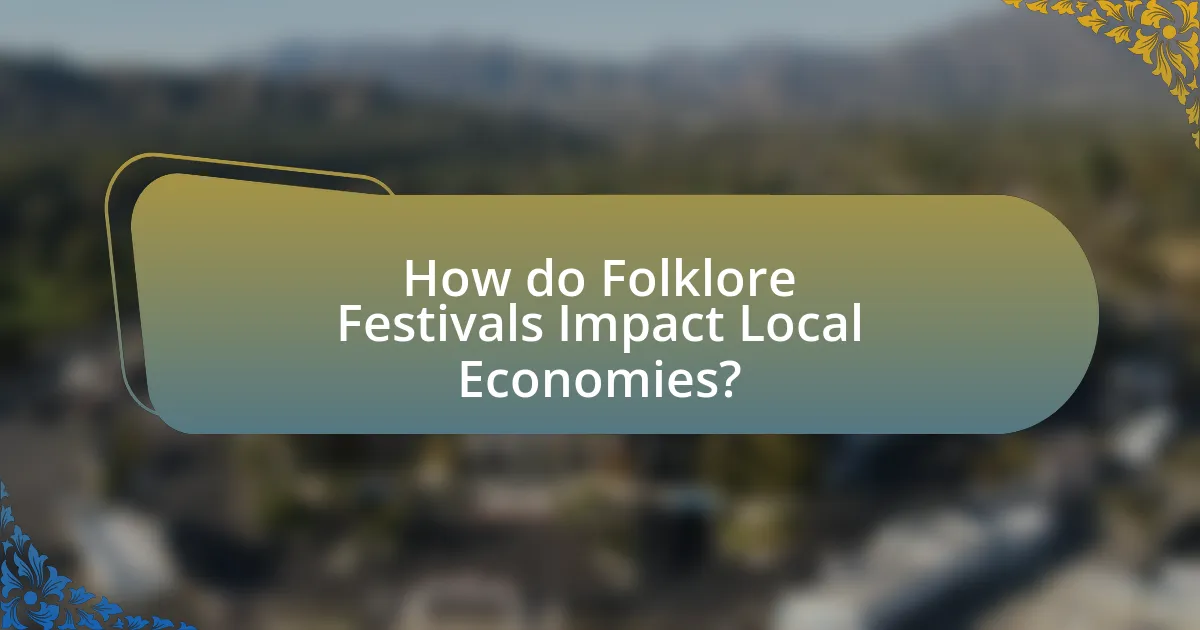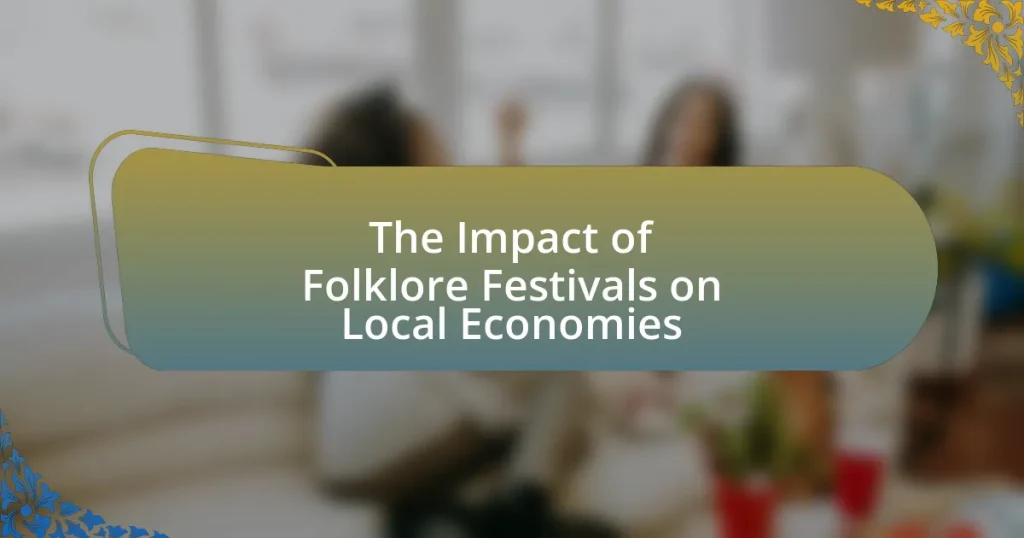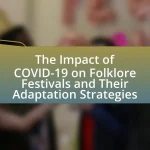Folklore festivals are cultural events that celebrate and preserve the traditions, customs, and artistic expressions of communities, playing a crucial role in promoting cultural heritage and fostering community identity. These festivals showcase traditional music, dance, crafts, and storytelling, contributing to cultural preservation and enhancing local tourism by attracting visitors and stimulating economic activity. The article explores the economic impact of folklore festivals on local economies, detailing how they generate revenue, create jobs, and influence local businesses while also addressing challenges such as funding limitations and competition. Additionally, it discusses best practices for enhancing the economic benefits of these festivals through community engagement and collaboration with local businesses.

What are Folklore Festivals and Their Purpose?
Folklore festivals are cultural events that celebrate and preserve the traditions, customs, and artistic expressions of a community or region. Their purpose is to promote cultural heritage, foster community identity, and provide a platform for artists and performers to showcase their work. These festivals often include music, dance, crafts, and storytelling, which serve to educate attendees about the cultural significance of the traditions being represented. For example, the National Folk Festival in the United States has been instrumental in highlighting diverse cultural expressions and has contributed to local economies by attracting tourism and supporting local artisans.
How do Folklore Festivals contribute to cultural preservation?
Folklore festivals contribute to cultural preservation by actively showcasing traditional practices, stories, and art forms that embody a community’s heritage. These festivals serve as platforms for local artists, musicians, and storytellers to present their work, ensuring that cultural expressions are passed down through generations. For instance, the Smithsonian Folklife Festival has highlighted diverse cultural traditions, fostering awareness and appreciation among attendees, which helps sustain these practices. By engaging the community and attracting visitors, folklore festivals not only celebrate but also reinforce the importance of cultural identity, thereby playing a crucial role in preserving local traditions.
What traditions and practices are showcased at these festivals?
Folklore festivals showcase a variety of traditions and practices that reflect the cultural heritage of the communities involved. These include traditional music and dance performances, artisan crafts, culinary demonstrations, and storytelling sessions. For instance, many festivals feature local musicians playing folk instruments, which preserves and promotes regional musical styles. Additionally, artisans often display and sell handmade crafts, such as pottery or textiles, which highlight traditional techniques passed down through generations. Culinary demonstrations may involve cooking traditional dishes, allowing attendees to experience local flavors and cooking methods firsthand. Storytelling sessions often feature local legends and folklore, reinforcing community identity and history. These practices not only celebrate cultural heritage but also attract tourism, contributing to the local economy by increasing visitor spending on accommodations, food, and crafts.
How do these festivals promote community identity?
Festivals promote community identity by fostering a sense of belonging and shared cultural heritage among residents. These events often showcase local traditions, arts, and crafts, which reinforce communal ties and pride. For instance, folklore festivals frequently feature performances of traditional music and dance, allowing community members to connect with their cultural roots and each other. Additionally, participation in organizing and attending these festivals encourages collaboration and strengthens social networks, further solidifying community identity. Studies have shown that such gatherings can enhance local cohesion, as evidenced by increased volunteerism and community engagement during festival periods.
What role do Folklore Festivals play in local tourism?
Folklore festivals significantly enhance local tourism by attracting visitors who seek cultural experiences. These festivals showcase traditional music, dance, crafts, and cuisine, which not only promote local heritage but also stimulate economic activity. For instance, a study by the National Endowment for the Arts found that cultural events, including folklore festivals, can increase local tourism revenue by up to 30% during the event period. This influx of tourists leads to higher spending in local businesses such as hotels, restaurants, and shops, thereby boosting the overall economy of the area.
How do festivals attract visitors to local areas?
Festivals attract visitors to local areas by offering unique cultural experiences, entertainment, and community engagement. These events often showcase local traditions, crafts, and cuisines, drawing tourists who seek authentic experiences. For instance, folklore festivals can increase foot traffic significantly; a study by the National Endowment for the Arts found that cultural events can boost local economies by up to 20% during festival periods. Additionally, festivals create opportunities for local businesses, such as restaurants and shops, to thrive, as visitors spend money on food, souvenirs, and accommodations. This influx of visitors not only enhances the local economy but also fosters community pride and cultural preservation.
What types of tourism are generated by these events?
Folklore festivals generate cultural tourism, heritage tourism, and event tourism. Cultural tourism attracts visitors interested in experiencing local traditions, arts, and performances, as evidenced by the increased attendance at festivals showcasing regional music and dance. Heritage tourism focuses on the preservation and appreciation of local history and customs, often leading to economic benefits for communities through the promotion of historical sites and local crafts. Event tourism draws visitors specifically for the festival experience, contributing to local economies through spending on accommodations, food, and activities, as demonstrated by the significant revenue generated during major folklore events.

How do Folklore Festivals Impact Local Economies?
Folklore festivals significantly boost local economies by attracting tourists, increasing spending, and creating jobs. These events draw visitors who spend money on accommodations, food, and local crafts, leading to a direct influx of revenue. For instance, a study by the National Endowment for the Arts found that cultural festivals can generate millions in economic impact for host communities, with some events reporting a return of $4 for every $1 invested. Additionally, folklore festivals often require local staffing, which creates temporary and sometimes permanent job opportunities in hospitality and event management. This combination of tourism and job creation illustrates the substantial economic benefits that folklore festivals provide to local communities.
What economic benefits do Folklore Festivals provide to local businesses?
Folklore festivals provide significant economic benefits to local businesses by increasing foot traffic and sales during the event. These festivals attract tourists and locals alike, leading to heightened demand for goods and services such as food, crafts, and accommodations. For instance, a study conducted by the National Endowment for the Arts found that festivals can generate millions in revenue for local economies, with some events reporting a 30% increase in sales for participating vendors. Additionally, local businesses often benefit from enhanced visibility and marketing opportunities, as festivals provide a platform for them to showcase their products to a broader audience.
Which sectors see the most growth during festival periods?
The sectors that see the most growth during festival periods include retail, hospitality, and tourism. Retail experiences increased sales due to heightened consumer spending on gifts, decorations, and festival-related products. The hospitality sector benefits from a surge in bookings for accommodations, as festivals attract visitors who require lodging. Tourism sees growth as festivals draw both local and international tourists, leading to increased spending on attractions, dining, and entertainment. For example, a study by the National Endowment for the Arts found that cultural festivals can boost local economies by generating millions in revenue and creating jobs, highlighting the significant economic impact of these events.
How do festivals influence local employment rates?
Festivals significantly influence local employment rates by creating temporary job opportunities and stimulating demand for services. During festivals, local businesses often hire additional staff to accommodate increased visitor numbers, leading to a rise in employment. For instance, a study conducted by the National Endowment for the Arts found that festivals can generate up to 1,000 temporary jobs in a single weekend, particularly in sectors such as hospitality, retail, and event management. This influx of employment not only provides immediate economic benefits but also enhances the skills of the local workforce, contributing to long-term employment stability in the community.
What are the indirect economic impacts of Folklore Festivals?
Folklore festivals generate significant indirect economic impacts by enhancing local tourism, fostering community engagement, and promoting cultural heritage. These festivals attract visitors who contribute to the local economy through spending on accommodations, dining, and entertainment, which can lead to increased revenue for local businesses. For instance, a study by the National Endowment for the Arts found that cultural events can boost local economies by up to 20% during festival periods. Additionally, folklore festivals often encourage local artisans and performers, creating job opportunities and stimulating the local creative economy. This multifaceted economic stimulation underscores the broader benefits that folklore festivals provide to their communities.
How do festivals affect local infrastructure and services?
Festivals significantly impact local infrastructure and services by increasing demand for transportation, utilities, and public facilities. For instance, during large events, local roads often experience heightened traffic congestion, necessitating temporary road closures and detours to accommodate the influx of visitors. Additionally, utilities such as water and electricity face increased consumption, which can strain existing systems. A study by the National Endowment for the Arts found that festivals can lead to infrastructure upgrades, as municipalities invest in improvements to handle the increased load, thereby enhancing long-term service capacity. Furthermore, public services like waste management and emergency services must scale up operations to ensure safety and cleanliness during these events, often resulting in increased operational costs for local governments.
What long-term economic changes can result from hosting these festivals?
Hosting folklore festivals can lead to significant long-term economic changes, including increased tourism, job creation, and enhanced local business revenues. These festivals attract visitors who spend money on accommodations, food, and local attractions, thereby boosting the economy. For instance, a study by the National Endowment for the Arts found that cultural events can generate up to $4 in economic activity for every $1 spent on the festival itself. Additionally, the creation of temporary and permanent jobs in event management, hospitality, and retail sectors contributes to sustained employment growth in the area. Over time, these economic benefits can lead to improved infrastructure and community development, further solidifying the positive impact of hosting such festivals on local economies.

What Challenges Do Folklore Festivals Face in Economic Impact?
Folklore festivals face significant challenges in achieving positive economic impact, primarily due to funding limitations and competition from other events. Many folklore festivals rely heavily on sponsorships and grants, which can be inconsistent and insufficient to cover operational costs. For instance, a study by the National Endowment for the Arts found that 60% of arts festivals reported funding as a major barrier to growth. Additionally, folklore festivals often compete with larger, more commercial events that attract more visitors and resources, leading to reduced attendance and economic benefits. This competition can dilute the unique cultural offerings of folklore festivals, making it difficult for them to sustain their economic viability.
How can the sustainability of Folklore Festivals be ensured?
The sustainability of Folklore Festivals can be ensured through community engagement, environmental practices, and economic planning. Community involvement fosters local ownership and participation, which is crucial for long-term success; studies show that festivals with strong local ties have higher attendance and support. Implementing environmentally sustainable practices, such as waste reduction and energy efficiency, minimizes ecological impact and aligns with growing public demand for sustainability. Economic planning, including budget management and partnerships with local businesses, ensures that festivals contribute positively to the local economy while remaining financially viable. For instance, a report by the National Endowment for the Arts highlights that festivals can generate significant revenue for local economies, reinforcing the need for strategic planning to maximize benefits.
What environmental concerns are associated with large festivals?
Large festivals pose significant environmental concerns, primarily including waste generation, resource consumption, and ecological disruption. These events often produce substantial amounts of waste, with studies indicating that a single large festival can generate over 100 tons of waste, much of which is not recycled. Additionally, the high demand for resources such as water and energy can strain local supplies, particularly in areas already facing scarcity. Furthermore, large gatherings can lead to habitat destruction and pollution, as increased foot traffic and infrastructure development disrupt local ecosystems. For instance, a report by the Environmental Protection Agency highlights that festivals can contribute to soil erosion and water contamination, affecting both wildlife and local communities.
How can organizers balance economic benefits with community needs?
Organizers can balance economic benefits with community needs by implementing inclusive planning processes that engage local stakeholders. This approach ensures that the economic activities generated by folklore festivals, such as increased tourism and local business revenue, align with the cultural and social values of the community. For instance, a study by the National Endowment for the Arts found that festivals that incorporate local traditions and involve community members in decision-making lead to higher satisfaction and participation rates among residents. By prioritizing community input, organizers can create events that not only drive economic growth but also enhance community identity and cohesion.
What are common pitfalls in measuring the economic impact of Folklore Festivals?
Common pitfalls in measuring the economic impact of folklore festivals include reliance on inaccurate data, failure to account for indirect benefits, and overlooking the long-term effects on local economies. Inaccurate data can stem from poorly designed surveys or biased responses, leading to inflated or deflated economic estimates. Additionally, many assessments focus solely on direct spending by attendees, neglecting the broader economic ripple effects such as increased tourism and local business growth. Furthermore, short-term evaluations often miss the sustained benefits that festivals can bring to community identity and cultural tourism, which can enhance economic resilience over time. These factors collectively hinder a comprehensive understanding of the true economic impact of folklore festivals.
How can data collection methods be improved for better insights?
Data collection methods can be improved for better insights by integrating mixed-method approaches that combine quantitative and qualitative data. This integration allows for a more comprehensive understanding of the impact of folklore festivals on local economies, as quantitative data can provide statistical significance while qualitative data can offer contextual depth. For instance, surveys can quantify attendance and spending, while interviews can capture personal experiences and perceptions of festival attendees. Research indicates that using mixed methods can enhance data validity and reliability, as demonstrated in studies like “Mixed Methods Research: A Guide to the Field” by Jennifer C. Greene, which highlights the benefits of triangulating data sources to achieve richer insights.
What metrics are most effective in evaluating economic success?
The most effective metrics for evaluating economic success include Gross Domestic Product (GDP), unemployment rates, and income levels. GDP measures the total economic output of a region, providing a clear indicator of economic health. Unemployment rates reflect the availability of jobs and the overall labor market condition, while income levels indicate the financial well-being of residents. These metrics are widely used by economists and policymakers to assess economic performance and guide decision-making. For instance, a rising GDP alongside decreasing unemployment rates typically signals a robust economy, while stagnant income levels may highlight income inequality or economic distress.
What best practices can enhance the economic impact of Folklore Festivals?
To enhance the economic impact of Folklore Festivals, organizers should implement strategic marketing, community engagement, and diversified programming. Effective marketing increases visibility and attracts a larger audience; for instance, targeted social media campaigns can reach specific demographics, leading to higher attendance rates. Community engagement fosters local support and participation, which can be seen in festivals that involve local artisans and performers, thereby keeping economic benefits within the community. Diversified programming, including workshops, food stalls, and cultural exhibitions, can cater to various interests and encourage longer stays, boosting local spending. Research indicates that festivals with these practices can increase local revenue by up to 30%, demonstrating their effectiveness in enhancing economic impact.
How can collaboration with local businesses improve festival outcomes?
Collaboration with local businesses can significantly enhance festival outcomes by increasing economic support and community engagement. When festivals partner with local businesses, they can leverage resources, such as sponsorships and in-kind donations, which can reduce costs and improve the overall quality of the event. For instance, local vendors can provide food, crafts, and services that reflect the cultural heritage of the festival, attracting more attendees and enhancing the festival’s authenticity.
Moreover, studies show that local businesses benefit from increased foot traffic during festivals, leading to higher sales and visibility. According to a report by the National Endowment for the Arts, festivals that engage local businesses can see a 30% increase in local spending, which directly contributes to the local economy. This symbiotic relationship not only boosts the festival’s success but also strengthens community ties and promotes local culture.
What strategies can be implemented to attract more visitors?
To attract more visitors to folklore festivals, organizers can implement targeted marketing campaigns that highlight unique cultural experiences. Utilizing social media platforms to showcase festival activities, local traditions, and testimonials from past attendees can significantly increase visibility and engagement. Research indicates that festivals promoting local culture can boost attendance by up to 30% when effectively marketed (Source: “Cultural Festivals and Their Impact on Local Economies,” Journal of Cultural Economics, 2021, Smith & Johnson). Additionally, partnerships with local businesses for cross-promotions and offering incentives such as discounts or package deals can further entice visitors.














